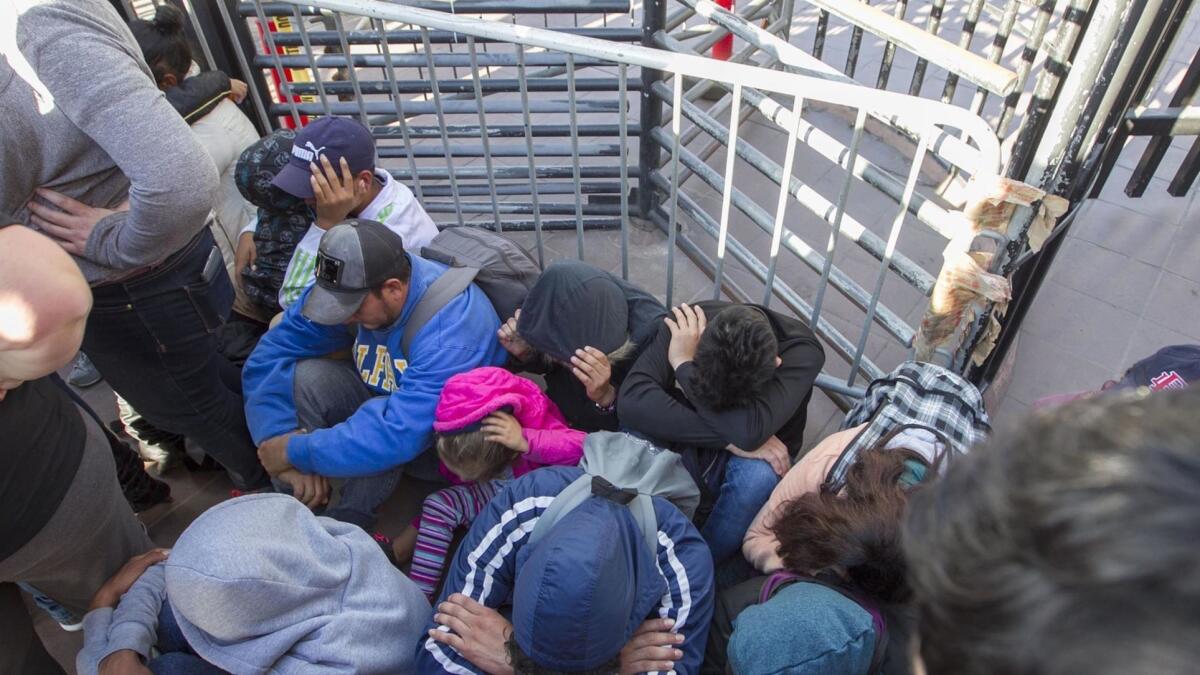Members of Congress accompany asylum seekers to Otay Mesa Port of Entry

- Share via
Two members of Congress accompanied 15 asylum seekers from the Central American caravan to the Otay Mesa Port of Entry on Monday to observe how U.S. officials treat asylum seekers.
Reps. Nanette Barragan and Jimmy Gomez, both of the Los Angeles area, questioned Customs and Border Protection officials after they were told the port would process only the eight unaccompanied children, and the rest, including a mother with five children, would have to go to the San Ysidro Port of Entry.
Officials at San Ysidro take a limited number of migrants each day for asylum processing, which has led to a backlog of thousands waiting in Tijuana.
“For me, it’s clear. We’re on U.S. soil,” Barragan said, referring to a law that prevents the U.S. from returning people to Mexico after they cross the international line if they are from another country.
She said officials have told Congress that migrants can request asylum at any port of entry but what she is witnessing at Otay Mesa contradicts that. She called the situation “unfortunate” and “disturbing.”
The asylum seekers, organized by legal aid group Al Otro Lado, were selected to participate because they are particularly vulnerable in Tijuana, volunteers said.
They walked up to the port of entry about 2:30 p.m. in small groups to avoid being noticed by Mexican immigration officials who might send them away before they reached their goal, the United States.
When they stepped over the border boundary, the asylum seekers, all from Honduras, sat down in hopes that officials would allow them in for asylum processing. A group of attorneys, law students and other volunteers who are all U.S. citizens formed a human shield around the sitting migrants to keep anyone from trying to force them back into Mexico.
Though officials initially said they would take the unaccompanied children, the entire group sat on concrete outside the port’s gate but past the international boundary for hours. A number of Customs and Border Protection officers with helmets stood nearby watching them and blocking one lane of traffic.
When a supervising officer told Barragan that they couldn’t take the mother and her five children or the man who was traveling alone because of capacity, Barragan asked to see inside the port of entry to understand its limitations.
The officer disappeared back into the port of entry to talk with higher ranking officials. When Barragan asked for an update from officers at the gate an hour later, they were unable to give her new information.
When asked about the incident, Customs and Border Protection, or CBP, pointed to an increase in asylum seekers arriving at ports of entry along the southwest border over the last year. The agency has limited resources and a variety of factors can influence how much space it has for asylum processing on a given day, according to a CBP spokeswoman.
“CBP processes undocumented persons as expeditiously as possible without negating the agency’s overall mission, or compromising the safety of individuals within our custody,” the spokeswoman said.
“As we have done for several years, when our ports of entry reach capacity, we have to manage the queues, and individuals presenting without documents may need to wait in Mexico as CBP officers work to process those already within our facilities,” she added.
Among the migrants sitting outside the Otay Mesa Port of Entry was a woman whose face became famous after she was photographed running with her children away from tear gas at the border weeks ago.
Attorney Nicole Ramos of Al Otro Lado stood over her.
Ramos has helped asylum seekers present at Tijuana ports of entry for years and observed as U.S. officials began sending them away a couple of years ago.
She questioned why the government hasn’t done more to speed up processing since it has known about the growing backlog for at least a year.
“It’s not representative of what the government has the financial capacity to do,” Ramos said.
After more than two hours, it was not yet clear what the outcome of the peaceful standoff would be. Both members of Congress promised to hold the agency accountable to U.S. and international law.
“What we’re doing is observing,” Gomez said. “Time will tell.”
Morrissey writes for the San Diego Union-Tribune.
More to Read
Get the L.A. Times Politics newsletter
Deeply reported insights into legislation, politics and policy from Sacramento, Washington and beyond. In your inbox twice per week.
You may occasionally receive promotional content from the Los Angeles Times.











